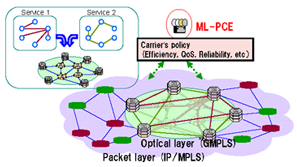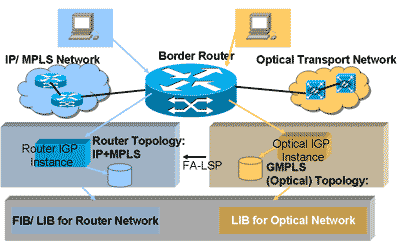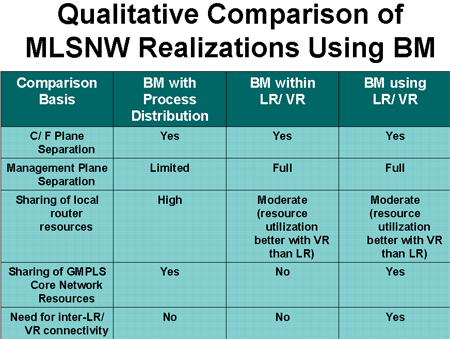Program
1. Program at a Glance
2. Online proceedings
3. Internet Access
1. Program at a Glance
Program at a Glance for print (pdf)
| Thursday 22, June 2006 |
Room: HORAI |
Room: FUJI-1 |
|
9:00-11:05
|
|
9:00-10:00
Photonic Internet Forum: General Meeting
(Closed Door at Room: KUJAKU) |
| |
10:30-13:30
Photonic Internet Forum:
5th Anniversary Symposium (Room: FUJI-1) (details) |
|
Exhibition
12:00 - 20:00 |
11:00-13:00 |
| 13:00-14:30 |
Lunch Break (on your own) |
| 14:30-16:10 |
Opening
Opening address
- Tomonori Aoyama, General Chair, Keio University
- Bijan Jabbari, General Chair, ISOCORE
Keynote
- Kireeti Kompella, Juniper Networks
Program introduction
- Tadanobu Okada, TPC Chair, NTT |
| 16:10-16:30 |
Break |
| 16:30-18:00 |
Special Session: Services and Operations on the Next Generation IP+Optical networkF
S-1 gGlobal Lambda Exchange,h Tom DeFanti, Univ. of Illinois at Chicago
S-2 gOperation and research on GMPLS optical network testbed of JGN II,h Shuichi Okamoto, NICT and Tomohiro Otani, KDDI Labs.
S-3 gNetwork service interface for Grid and application users and an experiment over a GMPLS network,h Tomohiro Kudoh, AIST |
Showcase Exhibition
18:00 - 20:00
|
18:00-19:00 |
|
19:00-20:00
|
Reception (Room: AIOI) |
 |
| Friday 23, June 2006 |
Room: HORAI |
Room: FUJI-1 |
Exhibition
10:00 - |
9:30-10:50 |
Tech. Session 1: Standardization, Testbeds and Public Demos
1-1 gTowards convergence of the GMPLS and ASON standards,h Lyndon Ong, Ciena Corporation
1-2 gKei-han-na interoperability demonstrations on interworking of inter-carrier ASON/GMPLS network domains,h Satoru Okamoto, Keio University
1-3 gOIF worldwide interoperability demonstrations on ASON inter-domain interfaces
- A carrierfs point of view,h Hans-Martin Foisel, Deutsche Telekom
1-4 gDevelopment of New Capabilities in DRAGON ? An Update on the Experimental GMPLS-based All Optical Testbed,h Jerry Sobieski, Mid-Atlantic Crossroads |
| 10:50-11:10 |
Break |
| 11:10-12:10 |
Tech. Session 2: Operation and Management
2-1 gPrototype demonstration of integrating MPLS/GMPLS network management system,h Kenichi Ogaki, KDDI
2-2 "Operating and Managing GMPLS Multi-Domain Networks,g Jan Van Bogaert, Alcatel Bell
2-3 gPolicy-based Management for Unified Traffic Engineering,h Dimitri Papadimitriou, Alcatel Bell |
Showcase
Exhibition
12:10 - 13:40
|
12:10-13:40 |
Lunch Break (on your own)
|
Exhibition
- 16:00
|
13:40-15:00 |
Tech. Session 3: New Mechanisms for GMPLS
3-1 gAdvanced Data Transport Support in GMPLS,h Richard Rabbat, Fujitsu Labs. of America
3-2 gTraffic engineering or network engineering? The transition to dynamic management of multi-layer networks,h Adrian Farrel, Old Dog Consulting
3-3 gGMPLS and Path Computation Element based Multi Layer Service Network Architecture,h Ichiro Inoue, NTT
3-4 gA server-based traffic engineering method in IP+Optical multi-layer networks,h Kohei Shiomoto, NTT |
| 15:00-15:20 |
Break |
| 15:20-16:20 |
Tech. Session 4: Deployment Strategies and Scenarios
4-1 gMPLS to GMPLS Migration: from Concept to validation - an Update,h Rajiv Papneja, Isocore
4-2 gA novel nodal and network architecture to realize GMPLS Based Multi Layer Service Network,h Hisashi Kojima, NTT
4-3 gInterworking and Operational Considerations for Deployment of the GMPLS Technology,h Zafar Ali, Cisco Systems, Inc. |
| |
16:20-16:40 |
Break |
| 16:40-17:40 |
Tech. Session 5: Services and Applications
5-1 gDistributed lambda-based internet exchange (IX) using GMPLS controlled photonic cross connects,h Takehiro Tsuritani, KDDI
5-2 gPacket and Optical Multi-Layer VPN Architecture: Opportunities and Challenges,h Hamid Ould-Brahim, Nortel Networks
5-3 gNext Generation Optical Services and L1VPNs: Business Scenarios, Technical Challenges and Current Effort,h Tomonori Takeda, NTT |
| 17:40-18:00 |
Closing Remarks :
Naoaki Yamanaka, Organization Committee Chair, Keio Univ. |
2. Online proceedings
| Opening |
Thursday 22, June 2006. 14:30-16:10
Opening address
- Tomonori Aoyama, General Chair, Keio University
- Bijan Jabbari, General Chair, ISOCORE
Keynote
Kireeti Kompella, Juniper Networks
GMPLS: How Far We Have Come! .
 This talk will describe the maturation of MPLS and GMPLS. In particular, there are three topics: the latest technical updates to the MPLS/GMPLS protocols; standards work, especially in the IETF, but also in the ITU-T and other bodies; and finally, the progress of deployment. The primary theme in this talk is that GMPLS has taken major strides forward from just being a "cool" idea to a useful and deployable technology. This talk will describe the maturation of MPLS and GMPLS. In particular, there are three topics: the latest technical updates to the MPLS/GMPLS protocols; standards work, especially in the IETF, but also in the ITU-T and other bodies; and finally, the progress of deployment. The primary theme in this talk is that GMPLS has taken major strides forward from just being a "cool" idea to a useful and deployable technology.
Biography: Kireeti Kompella is a Juniper Fellow at Juniper Networks. His current interests are all aspects of Multi-Protocol Label Switching, including Traffic Engineering, Generalized MPLS, and MPLS applications such as VPNs. Dr. Kompella is active at the IETF where he is a co-chair of the CCAMP Working Group and the author of several Internet Drafts and RFCs in the areas of CCAMP, IS-IS, L2VPN, MPLS, OSPF and TE. He specializes in Layer 2 VPNs, Metro Ethernet and Virtual Private LAN Service. Previously, he worked in the area of filesystems at Network Appliance and SGI; and earlier in the area of security and cryptography.Dr. Kompella received his B.S. in Electrical Engineering and M.S. in Computer Science at the Indian Institute of Technology, Kanpur; and his PhD in Computer Science at the University of Southern California.

Program introduction
- Tadanobu Okada, TPC Chair, NTT
|
| Special Session |
Services and Operations on the Next Generation IP+Optical networkF
Thursday 22, June 2006. 16:30-18:00
S-1 "Global Lambda Exchange"
Tom A. DeFanti, University of Illinois at Chicago
GLIF, the Global Lambda Integrated Facility, is a virtual organization that supports persistent data-intensive scientific research and middleware development. GLIF is defining GLIF Optical Lightpath Exchanges (GOLEs), open exchanges that facilitate the interconnectivity and interoperability of links. GOLEs have the goal of assuring the interconnectivity and interoperability of links by specifying equipment, connection requirements and necessary engineering functions and services. Computer scientists are exploring the development of intelligent optical control planes and new transport protocols, building on the wealth of middleware that currently exists. E-science teams are the primary drivers for these new application-empowered networks. GLIF is building more than a network; it is building an integrated facility in which broad multidisciplinary teams can work together.StarLight in Chicago and NetherLight in Amsterdam are two important examples of persistent GOLEs.
A GLIF GOLE was constructed for the iGrid 2005 Workshop at Calit2, University of California, San Diego, in September 2005. To feed into this experimental GOLE at iGrid2005, National Research & Education Networks (NRENs), countries, consortia, companies, institutions and individual research initiatives provided the heterogeneous equipment and circuits. IGrid 2005 demonstrated global application experiments running a new generation of shared open-source LambdaGrid Services supporting: scientific instruments, high-definition video and digital cinema streaming, visualization and virtual reality, high-performance computing, data analysis, and the control of the underlying lambdas themselves. Such services support very-large-scale e-science applications such as astronomy, bioinformatics, environmental, geoscience, and high-energy physics that study very complex micro- to macro-scale problems over time and space. IGrid2005 specifically featured very advanced media and network services, a quantum leap from delivering the web's kilobyte texts and megabyte images to interactively visualizing gigabyte datasets as well as streaming HDTV and 4K resolution motion imagery.
GLIF's larger mission is to create and sustain a global-scale facility that supports leading-edge capabilities based on new and emerging technologies and methods related to advanced optical networking. GLIF provides leadership in advanced technologies and pre-production services on behalf of NRENs, NREN consortia, or pan-continental Research and Education Networks, creating new models that they can implement. As such services become available from NREN consortia, GLIF will refocus on emerging methods to support its communities.

Biography: Thomas A. DeFanti, PhD, at the University of Illinois at Chicago, is a director of the Electronic Visualization Laboratory (EVL), a distinguished professor and a distinguished professor emeritus in the department of Computer Science, and the director of the SoftwareTechnologiesResearchCenter. At the University of California, San Diego, DeFanti is a research scientist at the California Institute for Telecommunications and Information Technology (Calit2). DeFanti is an internationally recognized expert in computer graphics since the early 1970s. DeFanti has amassed a number of credits, including: use of EVL hardware and software for the computer animation produced for the 1977 "Star Wars" movie;contributor and co-editor of the 1987 National Science Foundation-sponsored report "Visualization in Scientific Computing;" recipient of the 1988 ACM Outstanding Contribution Award; and appointed an ACM Fellow in 1994.He shares recognition along with EVL director Daniel J. Sandin for conceiving the CAVE virtual reality theater in 1991. Striving since then to connect high-resolution visualization and virtual reality devices over long distances, DeFanti has collaborated with Maxine Brown of UIC to lead state, national and international teams to build the most advanced production-quality networks available to academics, with major NSF funding; he is PI of the TransLight/StarLight IRNC Award which provides two 10Gb/s connections to Amsterdam's NetherLight, and he is a founding member of the Global Lambda Integrated Facility (GLIF). Domestically, DeFanti established the 10 Gigabit Ethernet CAVEwave research facility over the National LambdaRail between WashingtonDC, Chicago, Seattle, and San Diego as a model for application-driven future high-end science and engineering collaboration infrastructures.
S-2 "Operation and research on GMPLS optical network testbed of JGN II"
Shuichi Okamoto, NICT and Tomohiro Otani, NICH/KDDI Labs.
This presentation describes the overview of the GMPLS-controlled optical network testbed of JGN II and our operational experience and research results on JGN II GMPLS network. JGN II was constructed as an open network testbed for the purpose of promoting R&D activities of advanced networking technologies and network-related applications through collaboration with universities, public and private research institutions, industries, and local communities, and has been operated since April 2004. One of the most advanced features in JGN II is an introduction of GMPLS and optical cross connects (OXCs) technologies to a backbone network for the first time in Japan, in order not only to provide an gOXC path serviceh, but also to conduct the research projects related with GMPLS network control and management.
While we provide a point-to-point connection operated at 1Gbit/s (GbE) and 10Gbit/s (STM-64) to JGN II users as gOXC path serviceh, we evaluated and confirmed that the optical path can be not only immediately provisioned when a user request such a connection, but also effectively reconfigured during network maintenance thanks to the introduction of GMPLS-controlled OXCs. JGN II users now can receive the gOXC path serviceh with very high quality (whole bandwidth, low latency and jitter), which are especially suited for GRID computing as well as real-time applications. Moreover, by using GMPLS controlled routers, we have successfully transported IPv6 traffic as well as are providing MPLS interconnection to the other research network over JGN II GMPLS network. We will present the initial service strategy of providing the OXC path service through various operational experiences.
Since the GMPLS-controlled network is expected to allow us to more effectively and user-friendly manage optical networks, we are investigating a user-oriented mechanism to provision GMPLS optical paths over JGN II GMPLS network. We have recently developed wavelength on demand system in order to allow JGN II users by themselves to provision gOXC path serviceh using Web-based GUI. We allocated Linux-based GMPLS servers to some of OXC path service sites, which have GMPLS control plane engine and Web server functions, and evaluated the wavelength on demand system. Once the minimum information such as destination nodefs address or name and bandwidth was input to one of GMPLS servers, we confirmed that GMPLS servers successfully established the required GMPLS optical path without configuring various GMPLS parameters.
We will present how such a GUI-assisted user-access system is beneficial to the JGN II users as well as operators by indicating the actual system..
In conclusion, we summarize the current operational environment and our research result of operation about JGN II GMPLS network. We expect that JGN II will accelerate the development of GMPLS technologies among the industry and help to develop more enriched networking applications in order to arouse various services over GMPLS networks.

Biography: Shuichi Okamoto received the B.E. and M.E. degrees from Osaka University, Japan, in 2000 and 2003, respectively. He joined KDDI R&D Laboratories, Inc. in 2003. He has been a researcher of the National Institute of Information and Communication Technology (NICT) Tsukuba Research Center since June 2004. Currently he is investigating GMPLS technology from the operational point of view. He received the Young Researchers' Award from the Institute of Electronics, Information and Communication Engineers (IEICE) of Japan in 2006.
S-3 "Network service interface for Grid and application users and an experiment over a GMPLS network"
Tomohiro Kudoh, AIST
Grid is a technology which provides a single system image to users by virtualization of service infrastructure such as computing, data and network resources of multiple domains. By using Grid technology, users do not have to care about actual resources they are using. Grid middleware (such as planner, broker and scheduler) coordinates resources and provides virtual infrastructure.
To realize such virtual service infrastructure, resource management is one of the key issues. Grid middleware should allocate appropriate resources according to userfs request. Since network is among the resources of the service infrastructure, Grid middleware should allocate network resources as well as computing and storage resources.
Most of Grid middleware are implemented as Web Services. Web Services are application components which can be accessed thorough open standard web protocols (XML, SOAP, etc.). Web Services interface enables interaction between application components, and provide very high level interoperability among the components. To realize virtual service infrastructure for Grid, a standard Web Services based open interface between Grid middleware and network resource manager is required, but not yet established.
National Institute of Advanced Industrial Science and Technologies (AIST), KDDI R&D Laboratories and NTT are promoting collaborative project, called G-lambda, to establish such a standard Web Services interface, which is called GNS-WSI (Grid Network Service-Web Services Interface) between Grid and network resources.
At iGrid2005 and SC|05 conferences, which were held in September and November of 2005 respectively, we conducted an experiment where our Grid scheduling system co-allocated computing and network resources with advance reservation through the Web Services interfaces, in cooperation with National Institute of Information and Communications Technology (NICT). The experimental system controls the JGN II GMPLS network test bed, and realizes advance reservation of network paths as well as computing resources from a Grid scheduler.
In this presentation, I will briefly introduce Grid and Web Services technology, and discuss about requirements for the network service for Grid and applications. Then, I will introduce the G-lambda project and the experiment we conducted, and talk about future issues of the network service for Grid.

Biography: Tomohiro Kudoh received his Ph.D. degree from Keio University in 1993. He joined National Institute of Advanced Industrial Science and Technology (AIST) in 2002. He currently serves as the leader of the Cluster Technology Team of Grid Technology Research Center, AIST. In the past few years his research has focused on network as a Grid infrastructure. His recent work also includes the GridMPI project, which focuses on development of high performance MPI executed over Grid environment, and GbE/10GbE hardware network testbed GtrcNET.
Program at a glance |
| Technical Session |
T1: Standardization, Testbeds and Public Demos
Friday 23, June 2006. 9:30-10:50
1-1. Towards convergence of the GMPLS and ASON standards
 Lyndon Y. Ong, Ciena Corporation Lyndon Y. Ong, Ciena Corporation
Overview
As a result of concerted activities spanning ITU-T, OIF, and IETF to marry ASON requirements and supporting GMPLS protocols, in conjunction with OIF interoperability testing, the industry has come a long way on the path towards protocol convergence with the base GMPLS and ASON signaling protocols now largely in common. This effort to marry ASON requirements and protocols is making the fastest progress in the routing domain, as exemplified by joint activities of ITU-T, OIF, IETF representatives at IETF in developing RFC 4258. The joint IETF/ITU-T/OIF routing design team work has led to a number of extensions to GMPLS routing required to meet ASON requirements, as will be described in this paper.
Initial Signaling Differences and Interworking Methods
Extensions to the GMPLS signaling protocols (RSVP-TE and CR-LDP) were initially defined in the OIF and ITU-T based on a number of concerns with domain boundaries and addressing spaces in the ASON model, and resulted in the ITU-T Recommendations G.7713.2 and G.7713.3. The differences between these and the core GMPLS signaling protocols (RFC 3472 and 3473) were few in number, but turned out to be larger in impact due to the impact on use of session identifiers in RSVP.
The main extensions were the application of call and connection separation, and the separation of client domain and address space and network domain(s) and address space(s) in ASON. These had the impact of defining a separate range of call-related objects such as the Call ID and Transport Network-Assigned address (TNA), and the use of distinct sessions at the UNI and E-NNI boundaries. Unfortunately this led to the requirement for protocol interworking between and ASON interface and a GMPLS signaling domain.
Nonetheless, a number of demonstrations of interworking have been done in practice and are discussed in other papers to this conference.
Routing Differences and Plans for Convergence
ASON routing work followed the same principles of domain separation and isolation as in signaling, but instead of definition of parallel protocol specifications, the groups have pursued joint design of extensions needed for GMPLS routing protocols to support requirements of ASON networks. These extensions (in prototype form) have been tested through the OIF interoperability program.
The main extensions required for ASON routing support include:
-- support of the separation of transport plane, signaling control and routing control
-- support of advertisement of client address reachability
-- support of bandwidth advertisement suited to the ASON/SDH model of layered networks
-- support of advertisement of local connection type and adaptation capabilities for multi-layer networks
-- support of potential hierarchical organization of routing areas for scalability and policy control
The paper explains how these extensions are being addressed in the routing protocols and the plans for convergence through completion of IETF specifications for GMPLS extension, related OIF work on Implementation Agreements and follow-on ITU-T specifications, as well as the applications that are foreseen for these extensions. In addition, some discussion is added concerning the Path Computation Entity work in IETF and how that might be applied to ASON networks.

Biography: Lyndon Ong is currently director of network control architecture in the CTO organization of Ciena Corporation, a supplier of intelligent optical and data transport equipment. He joined Ciena in 2001 after working at Nortel Networks, Bay Networks, and Bellcore/Telcordia. He received his doctoral degree in electrical engineering from Columbia University in 1991. He has had a long career in the area of control protocols, starting with the original team defining Signaling System 7 standards for North America, to working on ATM networking, IP QoS, and transport protocols, and finally the optical control plane. He has chaired groups in ITU-T Standards, currently chairs the Signaling Transport WG in IETF, and is the editor of the OIF E-NNI Signaling Implementation Agreement and E-NNI Routing Implementation Agreement.
1-2. Kei-han-na interoperability demonstrations on interworking of inter-carrier ASON/GMPLS network domains
 Satoru Okamoto, Keio University
and Tomohiro Otani, KDDI Labs. Satoru Okamoto, Keio University
and Tomohiro Otani, KDDI Labs.
Kei-han-na Info-Communication Open Laboratory Interoperability Working Group promotes the rapid GMPLS development and deployment. This consortium provides an opportunity to evaluate GMPLS interoperability among vendors and developing interwoking technologies between ASON network domains and GMPLS network domains using ASON External Network to Network Interface; E-NNI under multi-carrier circumstances.
In this paper, we will present results of demonstrating the interoperability among 4 operatorsf total 6 ASON and GMPLS networks. The results and the findings of this interoperability demonstration will be described e.g.:
- Interworking of PXC based Lambda Switch Capable; LSC network domains as well as TDM network domains
- Using ASON E-NNI signaling as an inter-carrier interface
- Using BGP based routing protocol as an inter-carrier interface
- Interworking between ASON User to Network Interface; UNI and GMPLS Internal Network to Network Interface; I-NNI
- Interworking between GMPLS I-NNI and ASON E-NNI
- Interworking between GMPLS domains via ASON E-NNI
- Call set up between ASON UNI and GMPLS UNI, e.g. interworking between ASON domain and GMPLS domain

Biography: Satoru Okamoto received the B.S., M.S. and Ph.D. degrees in electronics engineering from Hokkaido University, Hokkaido, Japan in 1986, 1988 and 1994 respectively. In 1988, he joined Nippon Telegraph and Telephone Corporation (NTT), Japan. Here, he has been engaged in research on ATM cross-connect system architectures, photonic switching systems, optical path network architectures, and developed GMPLS controlled HIKARI router systems.
He leads several GMPLS related interoperability trials in Japan, such as the Photonic Internet Lab (PIL), OIF world wide interoperability demo, and Kei-han-na Interoperability Working Group.
He moved to an Associate Professor of Keio University at 2006. He is now promoting several research projects in the photonic network area.
1-3. OIF worldwide interoperability demonstrations on ASON inter-domain interfaces - A carrierfs point of view
Hans-Martin Foisel, Deutsche Telekom
In 2005 the Optical Internetworking Forum (OIF) has carried out extensive interoperability testing and demonstrations of ASON control and data plane inter-domain interfaces, e.g. User Network Interfaces, UNI2.0Ethernet, and External Network-Network Interfaces, E-NNI. The event was carried out in a globally distributed manner, comprising 7 carrier labs from Asia, North America and Europe interconnected by virtual E-NNI links and 13 industry leading vendors and was demonstrated live at SuperCOMM2005.
The results and the findings of this interoperability event will be described from a participating carrierfs perspective, highlighting the unique characteristics of this demonstration, e.g.:
- First dual-layer integrated data and control plane interface demonstration enabling Ethernet Private Line services over multi-domain, SDH/SONET based ASON networks
- Highlight the integration of multiple standards and specifications from several standardization bodies and forums for accomplishing the UNI2.0 Ethernet functions
- Interoperability of UNI/Ethernet and E-NNI/SDH functions
- Separation of transport network and client view, even on the technology level
- Simplifying the client side of the UNI ? ease client usage by maintaining the Ethernet format
Finally follow up or closely related R&D activities will be listed, underlining that this event is not a single, isolated activity but rather a major step on the continuous work towards implementation in real networks

1-4. The DRAGON Project and Application Controlled Networks A future space of hybrid application oriented service networks.
Jerry Sobieski, Mid-Atlantic Crossroads, Tom Lehman, University of Southern California/ISI-East, Bijan Jabbari, George Mason University and Don Riley, University of Maryland
This presentation will provide an update on the development of new capabilities in the experimental high end scientific all optical testbed network in the US.
The testbed which is part of the effort referred to as DRAGON (Dynamic Resource Allocation via GMPLS Optical Networks) project deals with research and development of technologies to enable dynamic provisioning of network resources on an inter-domain basis across heterogeneous network technologies.
The talk will discuss the incorporation of new capabilities developed and deployed in the DRAGON network recently. These include interdomain Routing and Path Computation, Multi-Region Traffic Engineering (TE) Label Switched Path (LSP) and User Interface for instantiation of Services.
The architecture of each component will be described and the experience from deployment will be shared.

Program at a glance |
T2: Operation and Management
Friday 23, June 2006. 11:10-12:10
2-1. Prototype demonstration of integrating MPLS/GMPLS network management system
Kenichi Ogaki, Masanori Miyazawa and Tomohiro Otani, KDDI Labs.
GMPLS (Generalized multi-protocol label switching) technology is expected to achieve efficient operation, administration and maintenance (OA&M), higher resource utilization and higher network resiliency, thanks to the introduction of a unified common control plane. Although such a GMPLS control plane provides the integration of routing and signaling aspects over different equipment of multiple layers such as routers, optical cross connects (OXC) and WDM equipments, the management of such equipment still depends on its own element management system (EMS) and remains non-integrated and separated. In this presentation, we propose an integrating architecture of the management plane for the MPLS/GMPLS network and report the results of a prototype demonstration of the management system. In order to effectively integrate the management functionality in the MPLS/GMPLS network, it is desirable to establish an overall architecture with a common management interface. To retrieve information from network, we adopt a simple network management protocol (SNMP) as a common management interface, some of which are standardized for a support of MPLS/GMPLS management information base (MIB). The basic functions for support of the MPLS/GMPLS management systems are considered to be required such as alarm management, provisioning of label switched paths (LSP), topology discovery, and correlation among MPLS, GMPLS and physical link layers.
A prototype of MPLS/GMPLS management system integrating MPLS/GMPLS network was developed for routers and OXCs. This system can automatically collect network topology information including nodes, TE-links and MPLS/GMPLS LSPs, and the status change of such information is dynamically updated. In order to discover and identify a node, and retrieve LSP information, SNMP effectively collect necessary inventories from nodes and indicate events such as a link failure and an LSP establishment. By using this system and a network testbed, once we provisioned GMPLS LSPs from one GMPLS router to another over multiple OXCs by, the management system immediately reflected the provisioned results in the topology map. Moreover, this system automatically correlated inventories among MPLS LSPs, GMPLS LSPs and links, and identified which MPLS LSPs were accommodated on top of the GMPLS LSP. This multi-layer correlation helps us to extremely improve the operation and management, because MPLS LSPs affected by a failure of a link is immediately identified. The more detailed results and functions will be presented in the conference. The verification with this developed prototype system indicates the effectiveness of our proposed architecture, and is expect to accelerate the deployment of GMPLS networks.

Biography: Kenichi Ogaki was born in Hiroshima, Japan, on September 17, 1973. He received the B.E. and M.E. degrees in system engineering from Osaka University, Osaka, Japan, in 1997 and 1999, respectively. In 1999, he joined KDDI R&D Laboratories, Inc., Saitama, Japan, engaging in research on optical networking.
2-2. Operating and Managing GMPLS Multi-Domain Networks
Jan Van Bogaert, Alcatel Bell and Dimitri Papadimitriou, Alcatel Bell
As the deployment of Generalized Multi-Protocol Label Switching (GMPLS) capable networks becomes progressively a reality, another reality comes into play when extending initial deployments from single to multi-domain networks: the operational field. Considerations related to operations and management of large scale GMPLS networks were, since so far, not examined with sufficient thoughtfulness and treated with enough meticulousness to respond to operational needs. In particular, when GMPLS is deployed in multi-domain networks such as multi-area or multi-AS networks.
This presentation briefly recalls the operators' expectations and requirements in terms of operations and management for multi-domain networks controlled by GMPLS. It then introduces the mechanisms and the tools that are enabled by the GMPLS protocol suite (in particular, RSVP-TE) to perform these control and management operations in multi-domain networks. Next, it discusses the suitability of these tools and mechanisms by comparing them and assesses their value against these requirements. This presentation concludes by illustrating the applicability of these tools and mechanisms against representative network examples.

2-3. Policy-based Management for Unified Traffic Engineering
Dimitri Papadimitriou, Alcatel Bell
Generalized Multi-Protocol Label Switching (GMPLS) is an enabler for seamless control integration of IP/MPLS, Ethernet and optical networks. Considering the GMPLS unified approach for resources provisioning and recovery techniques in multi-layer networks, requires unification of the traffic engineering mechanisms, policies and operations. The benefits come from the uniqueness of the traffic engineering operations that lowers complexity compared to the interactions that occur when maintaining multiple control plane instances. Control plane scalability and resource optimization are improved when using a coordinated traffic engineering and routing approach. Moreover, using a single control plane instance gives the opportunity to combine consistently Traffic Engineering (TE) capabilities and attributes within the scope of a single policy. However, since so far, policy has received very little attention while playing a fundamental role in enabling unified traffic engineering operations. Policy-based Management (PBM) enable network administrators to operate their network through rule-based policies that plays a key role during the service provisioning phases. The latter are then translated automatically into individual device configuration directives, aiming at controlling a network as a whole.
This presentation will first motivate introduction of policing for traffic engineering operations in multi-layer networks. It will then describe the role of PBM as an enabling technology for controlling traffic engineering operations in large-scale distributed systems, and for enforcing operational coherency through policy rules. Policy mechanisms for PBM operations including implementation techniques, enforcement criteria, and their integration into multi-layer network environments will then be analyzed in details. Use cases for policing combined resource and traffic oriented traffic engineering performance objectives during service provisioning will illustrate applicability of the PBM mechanisms.

Program at a glance |
T3: New Mechanisms for GMPLS
Friday 23, June 2006. 16:00 13:40-15:00
3-1. Advanced Data Transport Support in GMPLS
 Richard Rabbat, Fujitsu Labs. of America Richard Rabbat, Fujitsu Labs. of America
GMPLS holds the promise of automatic provisioning across regions and layers to decrease operational expenditure. Using GMPLS, a carrier has added control over the paths that it sets up at the different network layers. Due to increased competition, carriers are actively looking at technologies in the data and transport word that can satisfy their growing bandwidth needs at sustainable costs.
In support of these carrier requirements, equipment vendors have been focusing on making the transport network data-friendly. First, they have made it easy to carry Ethernet and other data services such as FICON/ESCON over Ethernet through the Generic Framing Protocol (GFP). Second, they have implemented an inverse multiplexing technology, Virtual Concatenation (VCAT), to allow a better mapping of Ethernet bit-rates to SONET circuits. In addition to the ability to distribute Ethernet over multiple circuits, the circuits do not need to be co-routed. Diversely routed paths allow better utilization of carrier capacity in the transport network. Finally, LCAS allows the fast resizing of bandwidth by adding or removing circuits to the group of virtually concatenated circuits.
While GMPLS was developed initially to support co-routed VCAT, we describe in this discussion new work at IETF to support the full set of data transport services including diversely routed VCAT and hitless resizing of VCAT groups using LCAS. We also describe the complete Ethernet/SONET model in order to allow the setup of Ethernet services by advertising a newly formed SONET/SDH LSP as a TE link at the higher layer. We highlight the interface adaptation and concatenation capabilities and motivate the collaboration between management and control plane in support of data transport services.

3-2. Traffic engineering or network engineering? The transition to dynamic management of multi-layer networks
 Adrian Farrel, Old Dog Consulting Adrian Farrel, Old Dog Consulting
With the acceptance of dynamic control planes for transport networks it becomes possible to integrate network engineering tools with the information gathering and provisioning processes of the control plane. The result is that it is possible to perform network engineering in real time which, in turn, opens up the possibility of performing integrated traffic engineering across multiple network layers.
This talk will introduce the most recent developments in Multi-Layer Networking (MLN), Path Computation Element (PCE), and Virtual Network Topology (VNT), and will show how these mechanisms can be used in concert to provide dynamic traffic engineering across all layers and technologies of a provider network.
Consideration will also be given to concerns about the generation of "topology on the fly" and the risks of wasted bandwidth through the "multiplexing server model". Appropriate techniques for controlling multi-layer network provisioning and network engineering through local policy, a Virtual Network Topology Manager (VNTM) and sophisticated traffic engineering tools will be described.
Adrian Farrel is Managing Director and Principal Consultant with Old Dog Consulting, and Co-Founder of Aria Networks. He the author of "GMPLS: Architecture and Applications" and "The Internet and Its Protocols" both published by Morgan Kaufmann. Adrian co-chairs three working groups in the IETF: The Common Control and Measurement Plane (CCAMP) working group responsible for developing GMPLS protocols; the Layer One Virtual Private Network (L1VPN) working group that applies GMPLS protocols to offer connectivity services across optical networks; and the Path Computation Element (PCE) working group that is developing architecture and protocols for cooperative remote computation servers. Adrian is co-chair of the Technical Program Committee for iPOP2006.

Biography: Adrian Farrel is co-chair of the IETFfs Common Control and Measurement Plane (CCAMP) Working Group, which is responsible for the development of the GMPLS family of protocols. He also chairs the Path Computation Element (PCE) Working Group, which is applying remote path computation techniques to MPLS and GMPLS networks, and the Layer One VPN (L1VPN) Working Group, which is developing mechanisms to manage connectivity over optical networks using GMPLS. He was a founding board member of the MPLS Forum, he is a regular attendee at ITU-T meetings that discuss the optical control plane, and he regularly serves on the technical committees for MPLS and GMPLS conferences.
Building on his 20 yearsf experience designing and developing portable communications software, Adrian runs a successful consultancy company, Old Dog Consulting, providing advice on implementation, deployment, and standardization of Internet Protocol-based solutions, especially in the arena of MPLS and GMPLS. Before this he was MPLS Architect and Development Manager at software house Data Connection, Ltd., and Director of Protocol Development for Movaz Networks, Inc., where he gained firsthand experience of building high-function GMPLS systems.
As well as frequently speaking at conferences, giving tutorials on MPLS and GMPLS, and authoring several white papers on GMPLS, Adrian is the author of The Internet and Its Protocols: A Comparative Approach (Morgan-Kaufmann 2004) which explains many of the IP-based protocols including those that make up MPLS and GMPLS. He is currently working on the text of a new book GMPLS: Architecture and Applications which is due out in November 2005.
3-3. GMPLS and Path Computation Element based Multi Layer Service Network Architecture
 Ichiro Inoue, NTT, JP Vasseur, Cisco, Zafar Ali, Cisco, Hisashi Kojima, NTT, Kaori Shimizu, NTT, Eiji Oki, NTT, Kohei Shiomoto, NTT and Shigeo Urushidani, NII Ichiro Inoue, NTT, JP Vasseur, Cisco, Zafar Ali, Cisco, Hisashi Kojima, NTT, Kaori Shimizu, NTT, Eiji Oki, NTT, Kohei Shiomoto, NTT and Shigeo Urushidani, NII
The bandwidth explosion by the popularity of the Internet has spurred the recent acceleration in the development and deployment of equipment supporting packet based broadband services. This coupled with the widespread deployment of WDM based Optical Transport Systems in the core network to satisfy the corresponding increase in capacity demand, has led network planners for tighter coordination between IP and Optical layers to increase reliability, robustness of next generation backbone network. Then, the core network needs to accommodate multiple network services in different layers, to achieve high efficiency in network resource according to dynamically changing requirements from different service demands, and to reduce operation, service provisioning, and failure reaction burden as well as their impact on multiple services by providing appropriate isolation among service and layers.
We propose a Multi Layer Service Network (MLSN) Architecture based on GMPLS, and path computation element (PCE). The proposed architecture is composed of multiple (routing) domains to accommodate GMPLS and non-GMPLS based technology. MLSN architecture is further described where a border node accommodates both GMPLS and non-GMPLS (i.e., MPLS/IP) with possible variety of data, control, and thus management plane entities providing isolation in operation, service, and information among the network layers. One typical example is that the two domains can have independent address spaces.
We show in detail our network architecture realizes smooth introducing GMPLS to cope with vast traffic explosion, sophisticated operation and service provision, and accommodating multiple different services. We also provide some numeric results in terms of resource utilization because it is a critical measure for the future network to be realistically efficient to introduce.
We propose that, PCE is used to bridge the isolated domains. PCE is used for path computation across the layers to realize end-to-end traffic engineering. We also discuss various realizations for the PCE server, including running PCE server at border nodes. End-to-end connection setup sequence when GMPLS tunnels are established on demand and when GMPLS tunnels are already established are also discussed.
Finally, we stress the need for standardization and interoperability activity to realize the proposed MLSN by showing the current GMPLS status.


Biography: Ichiro Inoue is a Senior Research Engineer, Supervisor, NTT Network Service System Laboratories. He received the B.E. and M.E. degree in electrical engineering from the University of Tokyo, in 1988 and 1990, respectively. He joined NTT the same year. Since then, his research
interests have included telecommunication protocols such as IP and ATM. He has been active in standardization such as ISO/ISC (as a national committee member), ITU-T, and IETF. He was a visiting researcher at Columbia University, USA in 1995. He is a member of IEEE and IEICE.
3-4. A server-based traffic engineering method in IP+Optical multi-layer networks
 Kohei Shiomoto, NTT, Eiji Oki, Ichiro Inoue, and Shigeo Urushidani, NTT Kohei Shiomoto, NTT, Eiji Oki, Ichiro Inoue, and Shigeo Urushidani, NTT
We have been proposing the IP+Optical multi-layer service network (MLSN), where multiple service networks are provided over the common core network [1]. Multi-layer traffic engineering is a crucial component in MLSN concept. Two key features in multi-layer traffic engineering include mechanisms for multi-layer path computation and virtual network topology (VNT) reconfiguration. Multi-layer path computation, which improves network resource utilization, is employed using both IP and optical TE topologies. VNT, which is regarded as IP-level network topology, is reconfigured by setting up and release optical LSPs using GMPLS protocols [2].
In order to make it easy to customize traffic-engineering mechanisms, we propose a server-based traffic engineering method for IP+Optical multi-layer networks. We take an IP/MPLS network as an example of a service network and demonstrate how an IP/MPLS service network is deployed based on our TE server called multi-layer path computation element (ML-PCE).
ML-PCE communicates with both service networks and core network, and collects TE topologies in IP/MPLS and GMPLS-based optical networksiFigure 1). It computes multi-layer paths based on the TE topologies information. In computing multi-layer paths, it avoids optical path creation as much as possible to save the resource in the core network. It is one of key requirements of MLSW that the already-deployed network service should not be impacted by introduction of GMPLS-based core network [3]. Because ML-PCE has multiple IGP instances to support the IP/MPLS service networks and the GMPLS core network, the already-deployed IP/MPLS networks are not affected while the GMPLS-based core network is newly introduced.
 |
 |
| Figure 1 |
Figure 2 |
ML-PCE is responsible for VNT reconfiguration. The VNT is reconfigured in response to traffic demand change, network failure, and network configuration change in IP/MPLS networks. Heuristic branch-exchange algorithm is employed to compute the VNT achieving high utilization while minimizing the number of different optical LSPs used in successive VNTs. Different VNTs are provided to different service networks on top of the common core networkiFigure 2).
We developed a proto-type system of ML-PCE and conducted experiments to examine scalability and stability using an experimental network consisting of the state-of-art commercial GMPLS-based routers and optical cross-connect systems. We also address how the proposed architecture is implemented using the international standard specification developed by IETF PCE WG. Possible protocol extensions are also discussed [4].
References@
[1] T. Kurimoto, et al., , gMultilayer coordination architecture based on multilayer service network architecture,h in Proc. iPOP 2005, Feb. 2005, Tokyo, Japan.
[2] Requirements for GMPLS-based multi-region networks (MRN) <draft-ietf-ccamp-gmpls-mrn-reqs-00.txt> (work in progress), January 2006.
[3] Framework for IP/MPLS-GMPLS interworking in support of IP/MPLS to GMPLS migration <draft-shiomoto-ccamp-gmpls-ipmpls-interwork-framework-00.txt>, October 2005.
[4] PCC-PCE Communication Requirements for Inter-Layer Traffic Engineering, <draft-ietf-pce-inter-layer-req-00.txt> (work in progress), November 2005.

Biography: Kohei Shiomoto is a Senior Research Engineer, Supervisor, Group Leader at NTT Network Service Systems Laboratories, Tokyo, Japan.
He joined the Nippon Telegraph and Telephone Corporation (NTT), Tokyo, Japan in April 1989, where he was engaged in research and development of ATM traffic control and ATM switching system architecture design. From August 1996 to September 1997, he was engaged in research on high-speed networking as a Visiting Scholar at Washington University in St. Louis, MO, USA. From September 1997 to June 2001, he was directing architecture design for high-speed IP/MPLS label switch router research project at NTT Network Service Systems Laboratories, Tokyo, Japan. From July 2001 to March 2004, he was engaged in the research fields of photonic IP router design, routing algorithm, and GMPLS routing and signaling standardization at NTT Network Innovation Laboratories. Since April 2004, he has been engaged in the research fields of photonic IP router design, routing algorithm, and GMPLS routing and signaling standardization at NTT Network Service Systems Laboratories. He is active in standardization of GMPLS in the IETF.
He received the B.E., M.E., and Ph.D degrees in information and computer sciences from Osaka University, Osaka in 1987 1989, and 1998, respectively.
He is a member of IEICE, IEEE, and ACM. He was a Secretary of International Relations of the Communications Society of IEICE from June 2003 to May 2005. He was a Vice Chair of Information Service of IEEE ComSoc Asia Pacific Board from January 2004 to December 2005. He was engaged in organization of several international conferences including HPSR 2002, WTC 2002, HPSR 2004, WTC 2004, MPLS 2004, iPOP 2005, MPLS 2005, iPOP 2006, and MPLS 2006. He received the Young Engineer Award from the IEICE in 1995. He received the Switching System Research Award from the IEICE in 1995 and 2000.
Program at a glance |
T4: Deployment Strategies and Scenarios
Friday 23, June 2006. 15:20-16:20
4-1. MPLS to GMPLS Migration: from Concept to validation - An update from Isocore, NTT and KDDI
 Rajiv Papneja, Isocore, Eiji Oki, NTT and Kenichi Ogaki, KDDI Labs. Rajiv Papneja, Isocore, Eiji Oki, NTT and Kenichi Ogaki, KDDI Labs.
Recently, the optical transport industry has made considerable progress towards a unified optical control plane internetworking and multi-vendor and multi-layer interoperability. New efforts are being made to simplify the network architecture that could trigger faster deployment of IP-optical based technologies and common control plane architecture.
This presentation aims to discuss the progress made during last year in terms of the stability of the implementations and the increase in the level of interoperability amongst the IP and Optical Transport devices. The talk will share the key observations from the various testing efforts carried out in the areas of common GMPLS addressing, MPLS to GMPLS Migration and Interworking, control plane interoperability, GMPLS overlay, and IP-Optical integration test scenarios that were successfully tested during Isocore Internetworking lab testing, and one being locally demonstrated at iPOP 2006. This presentation will share the experience from testing of implementations in an interoperable environment adhering to IETF GMPLS common addressing draft. Finally, the presentation will summarize the current state of the GMPLS based implementations and successful lab proof of concept models and future plans for continuing the join effort between Isocore, Carriers and Vendors.

Biography: Rajiv Papneja is a Manager at Isocore, and is responsible for technology validation and product evaluation group. Rajiv has been very actively involved and has contributed significantly in the integration of emerging IP technologies and Optical Transport Networks in a multi-vendor environment. Previously Rajiv has held position at Avici Systems working on high availability features of Internet routers. Rajiv holds a MS degree in EE from George Mason University, VA, USA.
4-2. A novel nodal and network architecture to realize GMPLS Based Multi Layer Service Network
 Zafar Ali, Cisco Systems, Ichiro Inoue, NTT, Hisashi Kojima, NTT and Shigeo Urushidani, NII Zafar Ali, Cisco Systems, Ichiro Inoue, NTT, Hisashi Kojima, NTT and Shigeo Urushidani, NII
One of the biggest concerns in todayfs network is how to deploy GMPLS technology to realize the benefits of it. The goal is to provide smooth migration for multiple services to a GMPLS controlled backbone providing tighter coordination between IP and Optical layers with increased reliability and robustness.
In this presentation, we propose a novel nodal architecture called border model which realizes multiple different layer/region/protocol instances at one single point, namely the border node.
We then demonstrate the proposed border model can meet such requirements, and eventually to realize the Multi Layer Service Network (MLSNW), which we have been proposing. The border model (BM) is suitable where Optical transport and IP service networks are administrated by different entities and would like to maintain a separation between layers, at the same, get the benefits of Peer model approach. The BM is also tailored to address deployment concerns associated with GMPLS technology to the existing networks. This presentation also details on how BM can be used for seamless migration of services to the MLSNW.
There are a number of ways in which service providers can offer value added services on top of the MLSNW using BM. When there is flat IP address space and services are managed by the Service Provider, the BM with process distribution approach applies. When the Service Providers provide the VPN services in a C to C style over GMPLS core, customer can directly attach to the border router for MPLS/ GMPLS circuits. The VPN customers may have overlapping address space and the service can be achieved using VRF aware BM. Another scenario is where Service Provider is providing customer managed VPN services, enabled by another BM which is within Logical Router (LR)/ Virtual Router (VR) or BM using LR/ VR.
In this presentation we elaborate on BM implementation using process distribution, VRF-aware BM, BM within LR/ VR and BM using LR/ VR. We also elaborate on applicability of each realization and provide qualitative comparison of these approaches. We also list some associated tradeoffs in selecting a specific realization. We show that each model has its own pros and corns and actual selection of a given realization depends on the requirements.




Biography: Hisashi Kojima is a research engineer, NTT Network Service System Laboratories. He received the B.E. and M.E. degree in information and communication engineering from Waseda University, Tokyo in 1997 and 1999, respectively. He joined NTT in 1999. Since then, his research interests have included IP/MPLS network architecture and IP optical network architecture.
4-3. Interworking and Operational Considerations for Deployment of the GMPLS Technology
Zafar Ali, Cisco Systems, Kenji Kumaki, KDDI Corporation, Tomohiro Otani, KDDI Labs. and Rama Ati, Cisco Systems
Introduction of GMPLS technology in existing IP/ MPLS networks and migration of IP/ MPLS services to GMPLS core poses some new requirements that does not exists while using point to point physical links in the core network. Feature richness of MPLS and GMPLS technology allows service providers to use a set of options on how GMPLS services can be used by IP/ MPLS networks. Legacy features have some implications on how IP/ MPLS networks can utilize forwarding and/ or routing adjacencies established on top of GMPLS networks. In this presentation we present these aspects of MPLS/ GMPLS interworking and operational considerations for deployment of the GMPLS technology.
From routing aspect, routing instance and addressing in the existing IP/MPLS are desired to be maintained as much as possible. GMPLS controlled routers, which is located at the border of the GMPLS core and the existing IP/MPLS service network, play an important role to achieve those requirements. Multiple routing instances for GMPLS and IP/MPLS equipped in those GMPLS border routers will enable to manage the routing information and addressing separately while keeping the loose linkage between these two instances by exporting only GMPLS FA-LSP information to IP/MPLS networks.
From signaling prospective, clearly there are two alternatives in which setup for GMPLS tunnel can be triggered: Static (pre-configured) and Dynamic (on-demand based on signaling setup request for MPLS LSP). The decision of weather to use static or dynamic FA-LSP requires operators to consider Bandwidth Fragmentation vs. config/ management burden tradeoffs. This presentation also presents these tradeoffs and related operational considerations.
Similarly there are tradeoffs and operational considerations associated when considering priority management between MPLS and GMPLS networks. Specifically, both MPLS and GMPLS LSP-es are signaled for specific setup and hold priority, based on the importance of traffic carried over them. For proper operation of the network, it is desirable to create/ use GMPLS LSPs of specified setup and hold priority, based on the setup and hold priority of the MPLS LSPs using them. In this regard, service providers may use exact match GMPLS LSP, Better match GMPLS LSP, dynamic Priority for GMPLS LSP, or no Priority Management in GMPLS core. In this presentation we also discuss advantages and disadvantages, related operational considerations and applicability statement for each approach.
Please refer to draft-kumaki-ccamp-mpls-gmpls-interworking-01.txt for details.

Program at a glance |
T5: Services and Applications
Friday 23, June 2006. 16:40-17:40
5-1. Distributed lambda-based internet exchange (IX) using GMPLS controlled photonic cross connects
Takehiro Tsuritani, KDDI, Masanori Miyazawa, Tomohiro Otani and Hedeaki Tanaka, KDDI Labs.
Recently, the traffic exchanged via Internet eXchanges (IXs) has been increasing, due to the emergence of new applications and services. Moreover, the traffic concentrations into some major IXs and the increase of the traffic delay have become issues in existing Layer-2 based IXs. These, in turn, will lead to the emergence of new IXs with lambda- rather than packet-based connection as well as higher quality and more reliable interconnections based on distributed IX architecture in the near future. In this presentation, the next-generation IX architecture using photonic cross connects (PXCs), hereafter referred to a distributed lambda-IX, which can controlled and managed by generalized multi-protocol label switching (GMPLS) technologies is proposed and the evaluated results are described. Our proposed distributed lambda-IX architecture consists of multiple GMPLS-controlled PXCs and a GMPLS-controlled autonomous system border router (ASBR) of each ISP, which can provision a dynamic and resilient interconnection on a lambda basis via PXCs between the ISPfs ASBRs by using GMPLS protocols. In order to hide the GMPLS routing information exchanged inside the lambda-IX from participating ISPs, we introduced a loosely routed GMPLS-label switching path (LSP) specified as a combination of strict and loose hops to the lambda-IX. The use of the loosely routed LSP was very beneficial not only to hide the OSPF routing information in the IX domain but also to dynamically choose the best route between two PXCs accommodating the ASBRs depending on the policy of IX operators. In addition, the establishment of an exterior border gateway protocol (eBGP) session over this LSP and the exchange of interior BGP routing information between ISPs have been achieved and eBGP session could be maintained even in the case of a cable failure thanks to the fast recovery operation of the lambda IX. These evaluated results considering actual operation will be described in more detail in the presentation. In conclusion, we believe the proposed distributed lambda-IX can be introduced in the future Internet world by employing the GMPLS control plane and PXCs.

5-2. Packet and Optical Multi-Layer VPN Architecture: Opportunities and Challenges
Hamid Ould-Brahim, Nortel Networks, Tomonori Takeda, NTT and Bilel Jamoussi, Nortel Networks
With the recent deployment of Provider based Virtual Private Network services such as layer-3 and layer-2 MPLS-based VPNs, and with the increasing interest in emerging layer-1 VPNs, combined with developments in intelligent GMPLS-based optical networks, the traditional VPN architecture is being challenged from its foundation. The network infrastructure is currently experiencing significant transformations that range from separating the control plane from the forwarding plane, to separating the signaling and the routing planes. This is resulting into the development of "transport independent" service architecture supported on a variety of network scenarios be it wide area, long haul, access or metro type networks. Furthermore, the recent development of IETF L1VPN standards will reinforce even further this VPN service architecture using common control plane, paving the way for a true multi-layer VPN service architecture.
The traditional paradigms and assumptions used when architecting the VPN service model are currently being revisited from the following aspects:
1) Connectivity service is only one of the objectives of the new VPN network architecture instead of being the only objective.
2) Connectivity can exist between a number of network endpoints (read customer sites) sharing common network properties, defined by the customer and enforced by the service provider.
3) The new VPN architecture MUST use open technology developed at the industry level.
4) The architecture is intended to smoothly integrate (and converge) multiple VPN services without major disruption to the existing carrier network infrastructure. This implies that a given carrier based VPN technology should not be developed in isolation of other carrier based VPN technologies.
5) The level of flexibility provided by the provider network to the customer constitutes an integral part of the service definition.
6) Reducing operational complexity for the customer and the service provider is considered a "MUST have" feature of any new VPN network technology.
From the above points, it results that the new VPN architecture is first a multi-layer VPN architecture and second is intended to operate in a network environment integrating packet and optical-based transport equipments, and third that architecture is mainly a client and network centric architecture and is characterized by:
- Intelligent functions for solving the level of operational complexity of existing networks.
- Unified "transport independent" control plane for network consolidations.
- Diversified transport technologies controlled through common control plane.
- Diversified VPN services built on the same provider network infrastructure.
This presentation explores the multi-layer VPN architecture from its services that span layer-3, 2 and layer-1 technologies and from its related architecture building blocks. The focus is to highlight the key opportunities and the main technical challenges.

5-3. Next Generation Optical Services and L1VPNs: Business Scenarios, Technical Challenges and Current Effort
 Tomonori Takeda, NTT Tomonori Takeda, NTT
This presentation focuses on next generation optical services, mainly Layer 1 Virtual Private Networks (L1VPNs), and describes their business scenarios, technical challenges and current effort to meet those challenges.
Traditional private line services are becoming expensive and not flexible. Emerging optical transport technologies, such as GE, 10GE and next generation SONET/SDH, offer a possibility to provide high-bandwidth optical services with low cost. Furthermore, by using Generalized Multi-Protocol Label Switching (GMPLS) technologies, optical connections can be provided much more flexibly, which creates more business opportunities for optical services. GMPLS adds capabilities such as fast service delivery and failure recovery, which offer tools not only for operational enhancement, but also for providing new services.
This presentation analyzes examples of business scenarios of next generation optical services. Business scenarios are classified as either carrierfs carrier type of service or customer service. The carrierfs carrier type of service provides services to customers who provide services themselves to other customers (e.g., enterprises and end-users). Examples of those customers are service network divisions in the same carrier and different carriers/ISPs. Customers can use optical transport networks without paying full cost of network equipments and operations. The customer service provides services to customers who use bandwidth by themselves. Examples of such service are video transport services, data backup services, and Grid computing. Customers can flexibly request bandwidth when needed.
Next, this presentation analyzes key service features and service migration. Key service features include monitoring, recovery, security, on-demand service delivery, and scheduling. Those service features would be gradually augmented as service evolves. The initial step of next generation optical services would be expected rather static. Additional capabilities, such as ones to flexibly modify bandwidth and connectivity, would be provided as technologies and operational tools become mature.
Finally, this presentation introduces current effort to meet these challenges. In particular, this presentation introduces standardization updates, mainly IETF activities to extend GMPLS, under the name L1VPNs. Several protocol pieces and alternatives are presented such as GMPLS-UNI and auto-discovery protocols. This presentation also discusses solution approaches to address advanced service features, such as ways to establish disjoint connections for improving reliability. Furthermore, implementation and interoperability status are presented.

Biography: Tomonori Takeda received the B.E. and M.E. degrees in Electronics, Information and Communication Engineering from Waseda University, Tokyo. Currently, he is with NTT Network Service Systems Laboratories, where his work is focused on the next-generation network architecture, IP optical network architecture and related protocols. He has been involved in standardization activities, including IETF and ITU-T, and co-chairs the Layer 1 Virtual Private Network (L1VPN) working group in the IETF.
Program at a glance |
| Closing Remarks |
Friday 23, June 2006. 17:40-18:00
Naoaki Yamanaka, Organization Committee Chair, Keio Univ. |
3. Internet Access
Wireless Internet access will be available at a conference room and an exhibition area.
|
|



